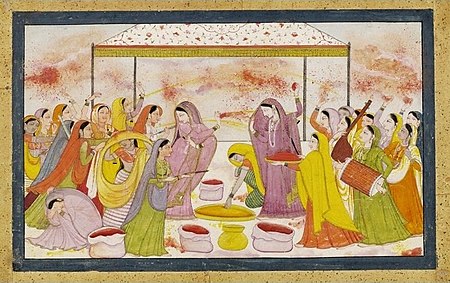
Pahari painting (literally meaning a painting from the mountainous regions: pahar means a mountain in Hindi) is an umbrella term used for a form of Indian painting, done mostly in miniature forms, originating from Himalayan hill kingdoms of North India, during 17th-19th century, notably Basohli, Mankot, Nurpur, Chamba, Kangra, Guler, Mandi and Garhwal. Nainsukh was a famous master of the mid-18th century, followed by his family workshop for another two generations. The central theme of Pahari painting is depiction of eternal love of Hindu deities Radha and Krishna.
The Pahari school developed and flourished during 17th-19th centuries stretching from Jammu to Garhwal, in the sub-Himalayan India, through Himachal Pradesh. Each created stark variations within the genre, ranging from bold intense Basohli Painting, originating from Basohli in Jammu and Kashmir, to the delicate and lyrical Kangra paintings, which became synonymous to the style before other schools of paintings developed, and finally to

the poetic and cinematic representations in Garhwali Paintings by Mola Ram. The Kangra style reached its pinnacle with paintings of Radha and Krishna, inspired by Jayadeva’s Gita Govinda.Pahari painting grew out of the Mughal painting, though this was patronized mostly by the Rajput kings who ruled many parts of the region, and gave birth to a new idiom in Indian painting. Some local antecedents have also been suggested, as a vivid Kashmiri tradition of mural paintings flourished between the 9th and 17th centuries, as seen in the murals of Alchi Monastery or Tsaparang.

